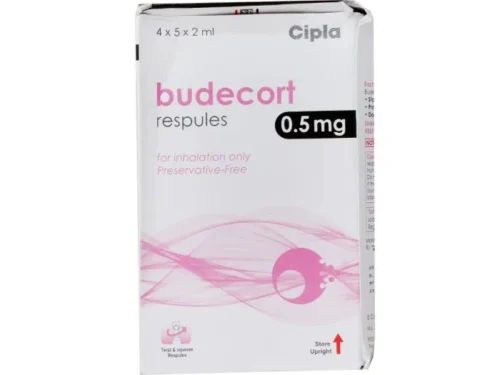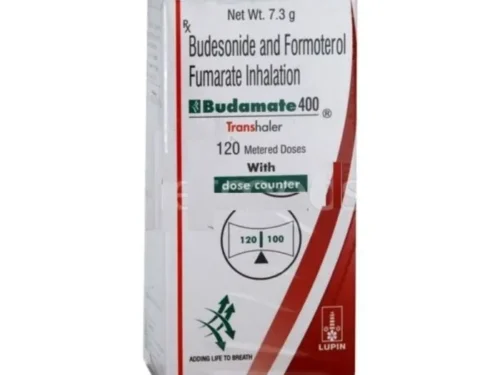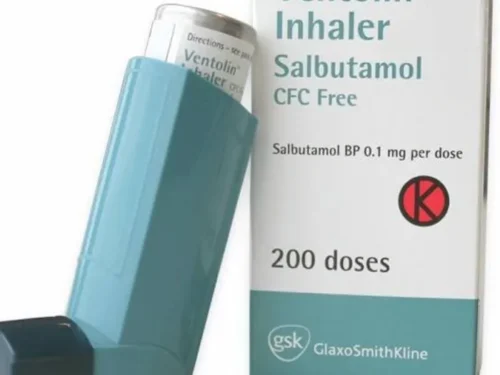Ventiphylline Syrup
Ventiphylline Syrup is a combination, prescription respiratory syrup commonly formulated to contain a bronchodilator (levosalbutamol), a mucolytic (ambroxol), and an expectorant (guaifenesin) in a single, palatable oral liquid.
Price range: $7.22 through $17.10
Availability: IN STOCK
Ventiphylline Syrup is a combination, prescription respiratory syrup commonly formulated to contain a bronchodilator (levosalbutamol), a mucolytic (ambroxol), and an expectorant (guaifenesin) in a single, palatable oral liquid. This multi-component approach targets key symptoms of lower respiratory tract congestion, bronchospasm, thick mucus, and impaired clearance, making Ventiphylline Syrup suitable for symptomatic management of cough with mucus, acute bronchitis, exacerbations of obstructive airways disease, and other conditions where loosening and clearing secretions together with bronchodilation is desirable. (Formulations and exact strengths can vary by manufacturer and country; the composition shown above reflects a commonly marketed “LS”/“PD” Ventiphylline syrup product.)
Key Features
| About | |
|---|---|
| Drug Class | Bronchodilators and Mucolytics |
| Subclass | Combination of Bronchodilator and Expectorant |
| Product Details | |
|---|---|
| Composition | Active ingredients:
|
| Packaging Type | Syrup |
| Pack Size | 60 ml |
| Dosage | Twice a day |
| Therapeutic class | Respiratory Medicine |
| Action Class | Bronchodilator and Mucolytic |
| Chemical class | Combination of Benzyl alcohol derivatives, Guaifenesin, and Beta-2 Agonist |
| Manufacturer | Yash Pharma Laboratories Pvt Ltd |
| Shelf Life | 2-3 years from the date of manufacturing |
| Usages | Treatment of asthma and Chronic Obstructive Pulmonary Disease (COPD) symptom. |
| Country of Origin | India |
| Storage | Store below 30°C in a cool and dry place, protected from direct sunlight, moisture, and heat. |
How Ventiphylline Syrup Works
Ventiphylline Syrup combines three complementary mechanisms:
- Bronchodilation (levosalbutamol): Levosalbutamol is the active enantiomer of salbutamol (albuterol). It selectively stimulates β₂-adrenergic receptors on airway smooth muscle, producing rapid bronchodilation that relieves wheeze and shortness of breath. This helps open airways so mucus can be more easily coughed up.
- Mucolysis / secretolysis (ambroxol): Ambroxol works on the mucous-producing mechanisms and mucociliary clearance — it reduces sputum viscosity and stimulates production of serous bronchial secretions, improving the transportability of mucus and promoting expectoration. This action reduces chest congestion and facilitates airway clearance.
- Expectorant action (guaifenesin): Guaifenesin increases the volume and reduces the viscosity of bronchial secretions, thinning phlegm and supporting cough efficiency so secretions can be expelled. Its expectorant effect complements ambroxol’s mucolytic properties.
Together, these agents address both the obstructive (bronchospasm) and secretory (thick mucus) components of many cough and chest-congestive presentations, allowing patients to breathe easier and clear secretions more effectively.
Indications / Uses
- Symptomatic relief of productive cough associated with acute bronchitis, colds with lower respiratory involvement, and other causes of mucus retention.
- Adjunctive therapy in asthma or COPD exacerbations where bronchospasm and mucus plugging coexist (used under clinician guidance).
- Supportive therapy in chest congestion with impaired expectoration — to improve clearance and reduce cough burden.
This medicine treats symptoms and improves comfort; underlying causes (bacterial infection, pneumonia, heart failure, etc.) require specific diagnosis and treatment. Use Ventiphylline only as directed by a healthcare professional.
Dosage & How to Use
Important: Follow the exact instructions on your product label or those provided by your prescriber. The following are typical directions for the common Ventiphylline LS formulation; confirm the strengths and dosing on the pack you have.
- Preparation & presentation: Supplied as a ready-to-use syrup in measured bottles (e.g., 60–100 mL) with a measuring cup or spoon. Shake well before each use to ensure uniform distribution of active ingredients.
- Typical dosing (adults): One 5 mL spoonful (containing the stated per-5-mL strengths) two to three times daily, usually every 8–12 hours, as advised by your clinician. Some labels recommend dosing on an empty stomach; follow pack directions.
- Pediatric dosing: Dose according to age or weight; junior formulations or pediatric dosing tables on the bottle should be followed closely. Never give adult doses to young children. Use the supplied measuring device.
- Duration: Use for the shortest effective period. If symptoms persist beyond the expected timeframe (typically a few days to a week) or worsen—fever, breathlessness, blood in sputum, seek medical review.
Do not combine with other single-ingredient salbutamol/levosalbutamol products without a clinician’s advice, and avoid simultaneous use with other mucolytic/expectorant combinations unless directed.
Expected Benefits
- Rapid bronchodilation reduces wheeze and breathlessness within minutes of administration of the bronchodilator component.
- Improved mucus clearance as ambroxol and guaifenesin thin and mobilize secretions, often producing a more effective productive cough and less chest tightness over several days.
- Improved sleep and daily functioning by reducing the frequency and severity of cough, and easing breathing during exertion.
- Convenience of combination therapy — a single syrup delivers bronchodilation plus mucolytic and expectorant support, simplifying regimens for patients who otherwise would take multiple medicines.
Realistic expectations: symptomatic relief often begins within hours for bronchospasm and within 24–72 hours for mucus-thinning effects; complete resolution depends on the underlying cause and adjunctive care (hydration, physiotherapy, antibiotics if indicated).
Side Effects
Most side effects are predictable from the individual components and are usually mild and transient when used at recommended doses.
Common / usually mild
- Tremor, nervousness, palpitations, or mild tachycardia from the bronchodilator (levosalbutamol).
- Gastrointestinal upset (nausea, vomiting, abdominal discomfort) from mucolytics or expectorants.
- Headache, dizziness, or lightheadedness.
Less common / clinically important
- Allergic reactions (rash, urticaria); discontinue if significant hypersensitivity occurs.
- Excessive tachycardia, chest pain, or severe tremor — stop and seek medical help if these occur.
- Rare CNS effects (agitation, confusion) at high doses or in susceptible individuals.
Report severe adverse events (breathing difficulty, severe dizziness, fainting, signs of anaphylaxis) immediately to emergency services.
Interactions & Important Clinical Notes
- Sympathomimetics: Combining Ventiphylline Syrup with other β₂-agonists may increase cardiovascular side effects. Use under medical supervision if overlap is needed.
- MAO inhibitors / tricyclic antidepressants: Concurrent use with non-selective MAO inhibitors or tricyclics can potentiate sympathomimetic effects — avoid or use with caution.
- CNS depressants and alcohol: Ambroxol and guaifenesin can increase drowsiness when combined with sedatives; avoid alcohol.
- Other cough medicines: Avoid duplicating active ingredients (e.g., other guaifenesin or ambroxol products) to prevent overdose.
- Pediatric and pregnancy considerations: Check product labeling — some components may be contraindicated or require specialist advice in pregnancy, lactation, or very young children.
Always provide a full medication list to the prescriber, including OTCs and herbal products.
Pharmacokinetics
Each component has distinct absorption and metabolism characteristics:
- Levosalbutamol is rapidly absorbed after oral administration and exerts systemic β₂ effects; oral bioavailability and onset are slower than inhaled formulations but still clinically meaningful for symptomatic bronchodilation.
- Ambroxol is well absorbed orally, metabolized in the liver, and concentrates in lung tissue, where it modulates secretion and mucociliary function.
- Guaifenesin acts primarily on the airway mucosa with limited systemic accumulation; it is metabolized hepatically and excreted renally.
Renal or hepatic impairment may alter clearance; consult a clinician for dose adjustments in significant organ dysfunction.
Precautions & Who Should Be Careful
- Cardiovascular disease: Use caution in patients with ischemic heart disease, arrhythmias, or severe hypertension due to β₂-agonist effects on heart rate and arrhythmia risk.
- Hyperthyroidism, diabetes, and seizure disorders: β₂-agonists can exacerbate tachycardia or influence glucose and potassium levels; monitor as advised.
- Pregnancy & breastfeeding: Use only if the potential benefits justify potential risks; consult your doctor. Ambroxol has been used in pregnancy in some settings, but confirm with your clinician.
- Allergy to sulfonamides or excipients: Check the full ingredient list for potential allergens.
Storage & Handling
- Store at room temperature away from direct sunlight per the product label. Keep the bottle tightly closed and out of reach of children. After opening, follow the manufacturer’s guidance on how long the bottle may be used. Shake well before each dose to re-suspend the active ingredients uniformly.
Practical Tips & Realistic Expectations
- Hydration helps: Drinking adequate fluids supports expectoration and enhances mucolytic/expectorant effectiveness.
- Follow technique and dosing: Use the provided measuring device; do not substitute household teaspoons.
- Avoid driving if drowsy: If the syrup causes dizziness or drowsiness, avoid tasks requiring alertness.
- When to see a doctor: Worsening breathlessness, high fever, chest pain, blood in sputum, or no improvement within 3–5 days warrant medical reassessment.
Conclusion
Ventiphylline Syrup (typical Levosalbutamol + Ambroxol + Guaifenesin formulation) is a pragmatic combination therapy for symptomatic management of productive cough and chest congestion. By combining rapid bronchodilation with targeted mucolytic and expectorant actions, it helps open airways and mobilize mucus so patients can breathe easier and recover comfort more quickly. Use under clinician guidance, adhere to dosing instructions, watch for cardiovascular or CNS side effects, and seek timely medical review for red-flag symptoms.
FAQs
Q: How soon will I feel relief after taking Ventiphylline?
A: Bronchodilation effects (less wheeze/shortness of breath) may be noticed within minutes to an hour; mucus-thinning benefits often become clearer within 24–72 hours. If there’s no improvement or symptoms worsen, consult your clinician.
Q: Can I give Ventiphylline Syrup to my child?
A: Pediatric dosing varies by product. Only use an age-appropriate formulation and follow the label or prescriber instructions. Many products have a junior syrup with specific doses for children.
Q: Is it safe to take with my antidepressant?
A: Inform your doctor — interactions can occur (notably with MAO inhibitors and some antidepressants). Don’t combine without medical advice.
Q: Can I use it with my inhaler?
A: Yes — Ventiphylline Syrup may be used alongside inhaled bronchodilators or steroids when prescribed, but coordinate timing and tell your prescriber about all meds to avoid duplication.
Q: What side effects should alarm me?
A: Seek urgent care for severe chest pain, sudden worsening breathlessness, fainting, severe rash, swelling of the face or throat, or signs of major allergic reaction.
References
| Select Bottle | 3 Bottle, 6 Bottle, 9 bottle |
|---|







Reviews
There are no reviews yet.